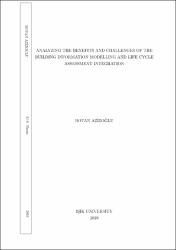| dc.contributor.advisor | Seyis, Senem | en_US |
| dc.contributor.author | Azizoğlu, Heval Botan | en_US |
| dc.contributor.other | Işık Üniversitesi, Fen Bilimleri Enstitüsü, İnşaat Mühendisliği Yüksek Lisans Programı | en_US |
| dc.date.accessioned | 2019-08-29T08:24:39Z | |
| dc.date.available | 2019-08-29T08:24:39Z | |
| dc.date.issued | 2019-07-17 | |
| dc.identifier.citation | Azizoğlu, H. B. (2019). Analyzing the benefits and challenges of the building information modelling and life cycle assessment integration. İstanbul: Işık Üniversitesi Fen Bilimleri Ensitüsü. | en_US |
| dc.identifier.uri | https://hdl.handle.net/11729/2152 | |
| dc.description | Text in English ; Abstract: English and Turkish | en_US |
| dc.description | Includes bibliographical references (leaves 31-33) | en_US |
| dc.description | vii, 36 leaves | en_US |
| dc.description.abstract | The architecture, engineering and construction (AEC) industry involves the large quantities of material and energy consumption. Previous studies show that the AEC industry consumes about 40 percent of primary energy utilization and contributes up to more than half of global GHG emissions. With the aim of decreasing these negative impacts of AEC industry on the natural environment, the integrated use of advanced technological instruments has been increasing in the last decade. One of the promising technological instrument integrations is the collaborative use Building Information Modeling (BIM) and Life Cycle Assessment (LCA) which is able to decrease negative impacts of AEC industry on natural environment in an e ective and e cient manner. The objective of this MS thesis is to identify, classify and prioritize the bene ts and challenges of the integrated use of Building Information Modelling and Life Cycle Assessment in the AEC industry. In order to achieve research objectives of this thesis, a comprehensive literature review, semi-structured interviews with experts and Delphi method were performed. The interrater agreement and signi cance-level statistics were conducted for analyzing and validating the consensus among the Delphi method participants. Results of this study provide twenty-two types of bene ts and seven types of challenges for the integrated use of BIM and LCA in the AEC industry. The contributions of this thesis are a comprehensive identi cation, classi cation and prioritization of the integrated use of BIM and LCA. The results of this study may contribute to extend utilization of BIM-LCA integration in the AEC industry. | en_US |
| dc.description.abstract | Günümüzdeki enerji ve malzeme tüketiminin çoğunluğuna mimarlık, mühendislik ve inşaat sektörü neden olmaktadır. Yapılan çalışmalar, inşaat sektörünün birincil enerji kullanımının yaklaşık % 40'ına ve küresel sera gazı emisyonlarının yarısından fazlasına neden olduğunu göstermektedir. Geçtiğimiz on senede inşaat ve mühendislik sektörlerinin çevreye olan olumsuz etkilerini azaltmak için kullanılabilecek yeni teknolojik araçlar geliştirilmiştir. Bu yeniliklerin önde gelenlerinden bir tanesi çoğunluğuna mimarlık, mühendislik ve inşaat sektörünün olumsuz çevresel etkilerini etkili ve verimli bir şekilde azaltan Yaşam Döngüsü Analizi (LCA) ile Yapı Bilgi Modellemesi (BIM)'nin entegrasyonudur. Bu yüksek lisans tezinin amacı, Yapı Bilgi Modellemesi ve Yaşam Döngüsü Analizi entegrasyonun faydaları ve zorluklarını tespit etmek, sınıflandırmak ve önem derecelerine göre sıralamaktır. Bu tezin araştırma amacını gerçekleştirmek için kapsamlı literatür taraması, uzmanlarla yarı yapılandırılmış görüşmeler ve Delphi yöntemi uygulanmıştır. Delphi yöntemi katılımcıları arasındaki uzlaşmayı analiz etmek ve doğrulamak için değerlendiriciler arasında güvenilirlik ve anlamlılık düzeyi istatistikleri hesaplanmıştır. Bu çalışmalar sonucunda mimarlık, mühendislik ve inşaat sektöründe Yapı Bilgi Modellemesi ve Yaşam Döngüsü Analizi entegrasyonun kullanımı ile ilgili yirmi iki adet fayda ve yedi adet zorluk belirlenmiştir. Bu tezin katkıları, Yapı Bilgi Modellemesi ve Yaşam Döngüsü Analizi entegrasyonun mimarlık, mühendislik ve inşaat endüstrisinde kullanımının kapsamlı tanımlanmasını, sınıflandırılmasını ve önceliklendirilmesini sağlamaktadır. Bu çalışmanın sonuçları, mimarlık, mühendislik ve inşaat endüstrisinde Yapı Bilgi Modellemesi ve Yaşam Döngüsü Analizi entegrasyonunun kullanımının artmasına katkıda bulunabilir. | en_US |
| dc.description.tableofcontents | Problem Identification | en_US |
| dc.description.tableofcontents | Research Objective | en_US |
| dc.description.tableofcontents | Scope of the Study | en_US |
| dc.description.tableofcontents | Vision | en_US |
| dc.description.tableofcontents | Plan of the Study | en_US |
| dc.description.tableofcontents | Research Methodology | en_US |
| dc.description.tableofcontents | Literature Review | en_US |
| dc.description.tableofcontents | Benefits of BIM-LCA Integration | en_US |
| dc.description.tableofcontents | Challenges of BIM-LCA Integration | en_US |
| dc.description.tableofcontents | Delphi Method | en_US |
| dc.language.iso | eng | en_US |
| dc.publisher | Işık Üniversitesi | en_US |
| dc.rights | info:eu-repo/semantics/openAccess | en_US |
| dc.rights | Attribution-NonCommercial-NoDerivs 3.0 United States | * |
| dc.rights.uri | http://creativecommons.org/licenses/by-nc-nd/3.0/us/ | * |
| dc.subject | Building information modelling | en_US |
| dc.subject | Life cycle assessment | en_US |
| dc.subject | Yapı bilgi modellemesi | en_US |
| dc.subject | Yaşam döngüsü analizi | en_US |
| dc.subject.lcc | TA145 .A95 2019 | |
| dc.subject.lcsh | Civil engineering | en_US |
| dc.subject.lcsh | Energy consumption | en_US |
| dc.title | Analyzing the benefits and challenges of the building information modelling and life cycle assessment integration | en_US |
| dc.title.alternative | Yapı bilgi modellemesi ve yaşam döngüsü analizi'nin entegrasyonunun faydalarının ve zorluklarının analiz edilmesi | en_US |
| dc.type | masterThesis | en_US |
| dc.contributor.department | Işık Üniversitesi, Fen Bilimleri Enstitüsü, İnşaat Mühendisliği Yüksek Lisans Programı | en_US |
| dc.relation.publicationcategory | Tez | en_US |
| dc.contributor.institutionauthor | Azizoğlu, Heval Botan | en_US |




















